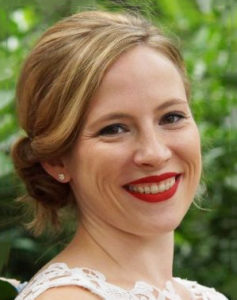After reading the title of this article, you may have taken pause – if so, you are not alone. The idea of providing sexuality education for very young children with ASD is likely to raise questions and may generate uncomfortable feelings; this can be a challenging topic. Despite the difficult aspects of broaching this subject, however, the good news is that the majority of parents of children with ASD do teach at least some sexuality-related concepts (Holmes & Himle, 2014). This is important because the Sexuality Information and Education Council of the United States (SIECUS) recommends sexuality education for all children, including children with development disabilities.

Shana Nichols, PhD

Krista Nelson, BFA
So, How Young Is ‘Young’ for Teaching?
It may be surprising that experts recommend starting age-appropriate sexuality education with children as young as three (Schwier & Hingsburger, 2000) and that comprehensive guidelines are available starting at the age of five (see SIECUS). Though this may seem quite young, for preschool and elementary aged children sexuality education provides foundational skills and knowledge related to understanding the body, touching, affection, and privacy rules.
What Impacts Parents’ Decisions About Teaching?
For children with ASD, recent research suggests that intellectual functioning, adaptive skills, and parental romantic expectations all influence the amount of sexuality education parents provide (Holmes, Himle, & Strassberg, 2015). Many parents express concerns about safety and a desire for their child to experience meaningful relationships, however they may not be comfortable addressing such topics with their child or they lack confidence in knowing what their child understands (Nichols & Blakeley-Smith, 2009).
Why Is It Important for Parents to Teach About Sexuality and Growing up from a Young Age?
Number one, parents are the best sexuality educators for their children. Though professionals can help, parents know their child best and are their most important and trusted teachers. By providing clear, simple, and proactive instruction, parents create an environment in which it is okay to discuss these topics, and they reduce the possibility of misinformation and confusion. Other important reasons for educating early include:
- Children with ASD follow the same course of psycho-sexual development as their same-aged peers
- Youth with ASD express interest in and experience sexuality (Holmes & Himle, 2014)
- Individuals with ASD are thought to be at higher risk of sexual victimization (Sevlever, Roth, & Gillis, 2013)
- Less knowledge about sexuality is associated with greater vulnerability to abuse (Brown-Lavoie, Viecili, & Weiss, 2014).
We Know It’s Important, Now What Do We Teach?
A child’s chronological age should guide WHAT to teach as part of socio-sexual education (Nichols, 2007). Two important considerations for children with ASD are that: (1) they will benefit from learning about some things, such as body changes, ahead of time; and (2) integrating sexuality education with social education is essential. The social element connects the dots about why certain behaviors are appropriate or not, given the context.
Ages 3-5
At this young age, children learn about their own and others’ body parts, differences between boys and girls, touch and affection, and privacy. Foundational social skills are a critical part of any curriculum. Teach the correct names for body parts (e.g., vagina, penis) and provide clear guidance about the concepts ‘public’ and ‘private.’
Ages 5-9
As children enter school, instruction should become more comprehensive and introduce the fact that bodies change as we grow up. Change can be difficult for children with ASD: discussing puberty will help kids know what to expect ahead of time. At this age, it is important to talk about friendships, communication, assertiveness and saying ‘no,’ and asking for help.
Ages 9-12
In the pre-teen years, discussions about puberty and safety become more specific (e.g., body hair) and skill-focused (e.g., hygiene). Personal values and decision-making become important, as does understanding of different social relationships. An emphasis on emotional development is critical, and teaching about romantic feelings may be relevant.
How to Teach – Tips and Resources
Together, a child’s developmental (cognitive) age and their learning style will guide HOW you teach (Nichols, 2007). In general, it is important to be clear, simple, and concrete. Use the child’s language when appropriate and avoid using euphemisms. Give specific examples across a range of situations and repeat. Get creative and integrate multi-sensory methods such as role plays and demonstrations, as well as individual and group experiences. For all children with ASD, but in particular for youth with cognitive and language challenges, it is particularly necessary to use visual strategies when teaching: pictures, schedules, videos, charts, books, dolls. Provide opportunities to practice skills (e.g., role play) or apply new knowledge. Remember to LISTEN as well as teach – understanding the child’s perspective and checking comprehension is crucial to effective teaching. Want to learn more? Some books on sexuality education for youth with ASD are listed below.
Resources
- Sexuality and Relationship Education for Children and Adolescents with Autism Spectrum Disorders: A Professional’s Guide to Understanding, Preventing Issues, Supporting Sexuality and Responding to Inappropriate Behaviours By D. Hartman
- When Young People with Intellectual Disabilities and Autism Hit Puberty: A Parents’ Q&A Guide to Health, Sexuality and Relationships By F.J. Brown & S. Brown
- Taking Care of Myself: A Hygiene, Puberty and Personal Curriculum for Young People with Autism By Mary Wrobel
Krista Nelson, BFA, is a PhD Doctoral Candidate at the Ferkauf Graduate School of Psychology at Yeshiva University and a Pre-doctoral Extern at ASPIRE Center for Learning and Development, and Shana Nichols, PhD, is a Licensed Psychologist and Owner, Director, and Researcher at ASPIRE Center for Learning and Development. For more information, please visit our website at www.aspirecenterforlearning.com or contact the ASPIRE team at info@aspirecenterforlearning.com.
References
Brown-Lavoie, S. M., Viecili, M. A., & Weiss, J. A. (2014). Sexual knowledge and victimization in adults with autism spectrum disorders. Journal of Autism and Developmental Disorders, 44(9), 2185-2196.
Holmes, L. G., & Himle, M. B. (2014). Brief report: Parent–child sexuality communication and autism spectrum disorders. Journal of Autism and Developmental Disorders, 44(11), 2964-2970.
Holmes, L. G., Himle, M. B., & Strassberg, D. S. (2016). Parental romantic expectations and parent–child sexuality communication in autism spectrum disorders. Autism, 20(6), 687-699.
Nichols, S. (2007). “But he/she is only 9 years old!”… Getting ready for growing up. On the Spectrum Newsletter, Association for High Functioning Autism Long Island.
Nichols, S., & Blakeley-Smith, A. (2009). “I’m not sure we’re ready for this…”: Working with families toward facilitating healthy sexuality for individuals with autism spectrum disorders. Social Work in Mental Health, 8(1), 72-91.
Schwier, K.M. & Hingsburger, D. (2000). Sexuality: Your Sons and Daughters with Intellectual Disabilities. Brookes Publishing.
Sevlever, M., Roth, M. E., & Gillis, J. M. (2013). Sexual abuse and offending in autism spectrum disorders. Sexuality and Disability, 31(2), 189-200.





